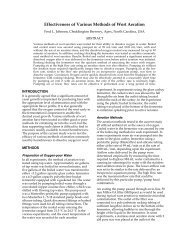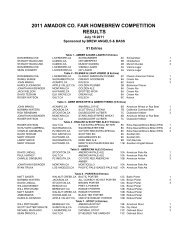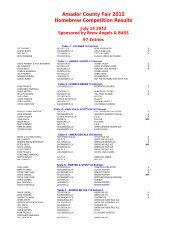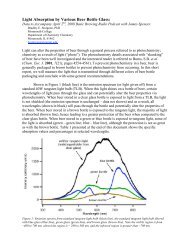A Homebrewer's Guide to Beer Flavor Descriptors - Brew Angels
A Homebrewer's Guide to Beer Flavor Descriptors - Brew Angels
A Homebrewer's Guide to Beer Flavor Descriptors - Brew Angels
Create successful ePaper yourself
Turn your PDF publications into a flip-book with our unique Google optimized e-Paper software.
Moldy<br />
By Greg Noonan<br />
Moldiness is a clearly recognizable flavor.<br />
Thankfully it is not a common defect in beer. It is<br />
evidenced by a cellarlike, damp‐earth or rank,<br />
cabbagy odor. The smell is usually more pronounced<br />
than the flavor, which may be woody or<br />
sour.<br />
In flavor profile, moldiness is grouped with<br />
staling characteristics (see <strong>Beer</strong> <strong>Flavor</strong> Terminology<br />
by Meilgaard, Dalgliesh and Clapper<strong>to</strong>n,<br />
1979). Oxidation, skunkiness, papery, cardboardy<br />
and leathery spoilage are classified as similar<br />
quality defects. Mild, barely detectable mustiness<br />
that develops in a bottled beer is an aging defect<br />
caused by a comparatively slight contamination.<br />
Where it is pronounced, moldiness‐mustiness is<br />
the result of serious fungal contamination. The<br />
contamination may be a result of airborne fungi, or<br />
from equipment or packaging the beer has contacted.<br />
Molds, like yeast, are fungi. Barley, malt,<br />
wort and beer are ideal substrates for the growth<br />
of a range of different fungi. Black bread molds,<br />
slimes and mildews can all grow in wort or beer.<br />
<strong>Brew</strong>ing in a damp or musty environment risks<br />
contamination of the cooled wort or fermenting<br />
beer by any of a host of airborne fungi.<br />
Secondary fermentation and aging in a moldy<br />
smelling cellar risks contamination by reverse<br />
passage of atmospheric air through the fermentation<br />
lock (sudden cooling) and by contact of the beer<br />
with exposed fermenter surfaces. Where the fer‐<br />
menter’s cap or s<strong>to</strong>pper seals against its rim offers<br />
a concealed, often moist area for fungal growth.<br />
Uncapping the brew for racking or priming risks<br />
contamination. Even a strongly fermenting beer<br />
should never be uncovered in a damp cellar. Even<br />
after transfer <strong>to</strong> a more sterile area the opening<br />
should be effectively sanitized.<br />
If airborne contamination can be reasonably<br />
eliminated as the probable source of infection,<br />
fermenters themselves and other articles and<br />
equipment contacting the brew must be suspect.<br />
In such cases more attention obviously needs <strong>to</strong> be<br />
paid <strong>to</strong> their sanitation. Adequate post‐cleaning<br />
contact time with a .05 <strong>to</strong> .5 percent sodium hypochlorite<br />
solution (.33 <strong>to</strong> 3 fluid ounces chlorine<br />
bleach in five gallons of water) acts as a most effective<br />
fungicide.<br />
The most obvious solution is indicated where<br />
moldiness is encountered sporadically in bottles<br />
from the same batch. Although airborne contamination<br />
at the point of bottling must always be<br />
suspect, more thorough sterilization of all bottles<br />
should be pursued. Promptly rinse bottles <strong>to</strong> be<br />
reused on emptying them, and sanitize by wet heat<br />
or soaking in a chlorine solution before refilling.<br />
Nutty<br />
By Fred Eckhardt<br />
Nuttiness is an olfac<strong>to</strong>ry(aromatic) sensation,<br />
as in Brazil nuts, hazel nuts or sherrylike. Olfac<strong>to</strong>ry<br />
sensations are perceived through cy<strong>to</strong>plasmic<br />
extensions up <strong>to</strong> the mucous in the nose. Our human<br />
olfac<strong>to</strong>ry abilities are relatively limited compared <strong>to</strong><br />
other mammalian species, but unlike them, we<br />
rarely take note of odors, even those emanating<br />
from the food we eat.<br />
Actually, our human olfac<strong>to</strong>ry recep<strong>to</strong>rs are better<br />
than even those of our sight and hearing! Our olfac<strong>to</strong>ry<br />
gland can detect an almost unlimited number of<br />
odors. Our sense of smell may actually be our best<br />
sense. Sadly, the only time we take our olfac<strong>to</strong>ry<br />
sensations seriously is during the actual ingestion of<br />
food and drink when they modify our taste sensa‐<br />
SPECIAL ISSUE 1987 ZYMURGY 45






